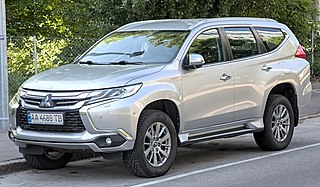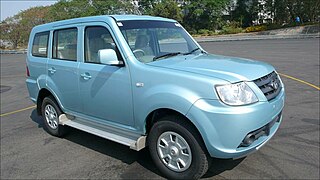
The Fiat Punto is a supermini car (B-segment) produced by the Italian manufacturer Fiat from 1993 to 2018, spanning over three generations. The third generation of the car was marketed between 2005 and 2009 as the Grande Punto, and between 2009 and 2012 as the Punto Evo, until the single-word Punto name was reintroduced. As of May 2013, nearly nine million units had been sold globally.

The Tata Indica was a B-segment car launched by the Indian manufacturer Tata Motors in 1998. It was the first Indian hatchback with a diesel engine. It was the first passenger hatchback from Tata Motors, with previous models being station wagons and SUVs. Indica is also considered one of India's indigenously developed passenger cars, though not the very first. As of August 2008, more than 9.1 lakh units had been produced and the platform had spawned close to 12 lakh vehicles. Annual sales of Indica were as high as 1,44,690 units in 2006–2007. As of July 2009, monthly sales of Indica were around 8,000 units. The models were also exported to European and African countries from late 2004. The car was discontinued in April 2018.

The Ford EcoSport is a subcompact crossover SUV (B-segment) manufactured by Ford between 2003 and 2023.

The Hyundai Tucson is a compact crossover SUV produced by the South Korean manufacturer Hyundai. It is named after the city of Tucson, Arizona. It was originally known as the Hyundai JM when it was introduced in Japan in 2004.

The Hyundai Accent, or Hyundai Verna is a subcompact car produced by Hyundai. In Australia, the first generation models carried over the Hyundai Excel name used by the Accent's predecessor. The Accent was replaced in 2000 by the Hyundai Verna in South Korea, although most international markets, including the US, retained the "Accent" name. The "Accent" name is an abbreviation of Advanced Compact Car of Epoch-making New Technology.

The Mitsubishi Pajero Sport is a body-on-frame mid-size SUV produced by the Japanese manufacturer Mitsubishi Motors using the Pajero nameplate since 1996. Based on the Triton pickup truck, the Pajero Sport has spanned over three generations. It is unrelated to the full-size Pajero, which is built on a unibody chassis since 1999 and was discontinued in 2021.

The Tata Sumo is a SUV produced by the Indian automobile manufacturer Tata Motors from 1994 to 2019. During production its name was changed to Sumo Victa and later to Sumo Gold.

The Tata Telcoline is a mid-size pickup truck made by the Indian automaker Tata Motors since 1988. In India, it was originally known as the Tatamobile 206, and since 2002, the name was changed to the Tata 207 DI. In export markets, it has been sold as the Tatamobile, Tata Loadbeta, or simply Tata Pick Up.

The Nissan Qashqai is a compact crossover SUV (C-segment) designed and produced by the Japanese car manufacturer Nissan since 2006. The first generation of the vehicle was sold as the Nissan Dualis in Japan and Australia, and Qashqai in the rest of the world. The second generation, launched in late-2013 for the 2014 model year, was not sold in Japan and was badged as the Qashqai in all countries it was sold, except in the United States, where it was rebadged as the Nissan Rogue Sport. Since the third and latest generation model launched in 2021, the Qashqai is available with hybrid powertrains.

The Hyundai i20 is a supermini hatchback produced by Hyundai since 2008. The i20 made its debut at the Paris Motor Show in October 2008, and sits between the i10 and i30. The i20 replaces the Getz in nearly all of its markets, while several markets received the slightly larger Accent/Verna hatchback to replace it instead.

The Volkswagen Polo Mk5 is the fifth generation of the Polo, a supermini-class car manufactured by Volkswagen since 2009. The vehicle unveiled at the 2009 Geneva Motor Show in March 2009, while the three-door version was unveiled at the 2009 Frankfurt Motor Show in September 2009. A four-door long-wheelbase sedan version has been produced and sold outside Europe in several emerging markets since 2010 either as the Volkswagen Vento or the Volkswagen Polo sedan. A short-wheelbase sedan version was sold in India between 2016 and 2020 as the Volkswagen Ameo.

The Tata Sumo Grande is a mid-size SUV produced by the Indian automobile manufacturer Tata Motors from 2008 to 2016. In 2014 the name was changed to Tata Movus.

The Hyundai Creta, also known as Hyundai ix25 in China, is a subcompact crossover SUV produced by Hyundai since 2014 mainly for emerging markets, particularly BRICS. It is positioned above the Venue and below the Tucson in Hyundai's SUV line-up.

The Tata Tiago is a 5-door hatchback city car made by Tata Motors in India since 2016.

The Tata Nexon EV is an electric car made in India, in the compact sport utility vehicle category. With an range of 453 km on one charge, it offers extended driving capabilities. It has a 40.5 kWh battery that can charge up to 80% in 56 minutes with a fast charger.

The Tata Harrier is a five-seater, diesel-engined compact crossover SUV produced by the Indian automaker Tata Motors Limited. It was launched in Indian market on 23 January 2019 and is positioned between the subcompact Tata Nexon and the mid-size Tata Safari.

The Mahindra XUV300 is a subcompact crossover SUV produced by the Indian automaker Mahindra & Mahindra. It is based on the X100 platform of SsangYong Tivoli and has been sold in Indian market since February 2019. Mahindra slotted it in the segment along with their Bolero Neo to rival the Maruti Suzuki Vitara Brezza, Tata Nexon and the Ford EcoSport.

The Hyundai Venue is a subcompact crossover SUV manufactured by the South Korean manufacturer Hyundai. The Venue debuted at the 2019 New York International Auto Show as Hyundai's smallest global crossover, prior to the introduction of other smaller SUVs such as the Casper and Exter.

The Kia Seltos is a subcompact crossover SUV manufactured by Kia. Introduced in mid-2019, the Seltos is positioned between the smaller Stonic, Soul, or Sonet and the larger Sportage in Kia's global SUV lineup.

The Maruti Suzuki Alto is a city car manufactured and marketed by Suzuki through its subsidiary Maruti Suzuki primarily for the Indian market since 2000. The first-generation model was essentially the Indian version of the fifth-generation Suzuki Alto kei car. The second generation was made as a standalone model, which was built on the same platform as the first generation. The third-generation model is built on the same underpinnings as the S-Presso.



























